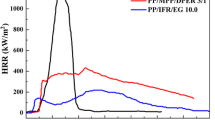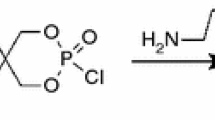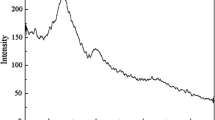Abstract
A phosphazene-based flame retardant (PBFA) was synthesized by hexachlorocyclotriphosphazene and N-aminoethylpiperazine. To improve the flame retardancy of polypropylene (PP), PBFA and pentaerythritol derivatives (PEPA) were mechanically mixed to form a water resistance intumescent flame retardant (IFR). The flammability and thermal properties of the PP composites were analyzed by vertical burning test (UL-94), limit oxygen index, thermogravimetric analysis (TGA) and cone calorimeter test (CCT). The results indicate that there was a synergistic effect between PBFA and PEPA at a suitable mass ratio. When the mass ratio of PBFA/PEPA was 2:1, the PP composites can successfully achieve UL-94 V 0 rating. Compared with pure PP, the peak heat release rate and the total heat release were decreased by 75.40 and 15.38%, respectively; moreover, the total smoke production decreased by 22.11% during 0–465 s. The residual char after CCT was characterized by Fourier transform infrared spectrometer (FTIR). A strong pyrophosphate absorption peak was found in FTIR, indicating that the IFR mainly played a flame-retardant mechanism in the condensed phase.









Similar content being viewed by others
References
Song P, Fang Z, Tong L, Xu Z. Synthesis of a novel oligomeric intumescent flame retardant and its application in polypropylene. Polym Eng Sci. 2009;49(7):1326–31.
Matzen M, Kandola B, Huth C, Schartel B. Influence of flame retardants on the melt dripping behaviour of thermoplastic polymers. Materials. 2015;8(9):5621–46.
Hu S, Song L, Pan H, Hu Y. Effect of a novel chitosan-based flame retardant on thermal and flammability properties of polyvinyl alcohol. J Therm Anal Calorim. 2013;112(2):859–64.
Peng HQ, Zhou Q, Wang DY, Chen L, Wang YZ. A novel charring agent containing caged bicyclic phosphate and its application in intumescent flame retardant polypropylene systems. J Ind Eng Chem. 2008;14(5):589–95.
Meng WH, Dong YL, Li JH, Cheng LY, Xu JZ, Hao JW, Qu HQ. Bio-based phytic acid and tannic acid chelate-mediated interfacial assembly of Mg(OH)2: concurrently synergism improved flame retardancy, smoke suppression and mechanical properties of PVC. Compos Part B-Eng. 2020;8368(19):34360–4.
Wang X, Wang Z, Li J. Effects of a semi-bio-based triazine derivative on intumescent flame-retardant polypropylene. Polym Adv Technol. 2019;30(5):1259–68.
He W, Qi F, Wang N, Chen X, Zhang K, Guo J. The influence of thermal oxidative ageing on flame retardancy, thermal and mechanical properties of LGFPP/IFR composites. J Therm Anal Calorim. 2018;131(2):1017–24.
Yu S, Xiao S, Zhao Z, Huo X, Wei J. Microencapsulated ammonium polyphosphate by polyurethane with segment of dipentaerythritol and its application in flame retardant polypropylene. Chin J Chem Eng. 2019;27(7):1735–43.
Wen P, Tai Q, Hu Y, Yuen RKK. Cyclotriphosphazene-based intumescent flame retardant against the combustible polypropylene. Ind Eng Chem Res. 2016;55(29):8018–24.
He LL, Zhang Y, Qin ZL, Lan YH, Li DH, Yang RJJAMR. Study on synthesis of cyclotriphosphazene containing aminopropylsilicone functional group as flame retardant. Adv Mater Res. 2013;683(4):25–9.
Qin Z, Li D, Lan Y, Li Q, Yang R. Ammonium polyphosphate and silicon-containing cyclotriphosphazene: synergistic effect in flame-retarded polypropylene. Adv Mater Res. 2015;54(43):10707–13.
Xu Y, Claiden P, Zhu Y, Morita H, Hanagata N. Effect of amino groups of mesoporous silica nanoparticles on CpG oligodexynucleotide delivery. Sci Technol Adv Mater. 2015;16(4):045006(1–11).
Yang R, Ma B, Zhao H, Li J. Preparation, thermal degradation, and fire behaviors of intumescent flame retardant polypropylene with a charring agent containing pentaerythritol and triazine. Ind Eng Chem Res. 2016;55(18):5298–305.
Yang G, Wu WH, Wang YH. Synthesis of a novel phosphazene-based flame retardant with active amine groups and its application in reducing the fire hazard of epoxy resin. J Hazard Mater. 2019;366(9):78–87.
Wang W, Wen P, Zhan J. Synthesis of a novel charring agent containing pentaerythritol and triazine structure and its intumescent flame retardant performance for polypropylene. Polym Degrad Stabil. 2017;144(13):454–63.
Zhang NE, Zhang M, Zhang J. Flexible water-resistant intumescent coatings: fabrication, characterization, and fire protective performance. Prog Org Coat. 2019;137(9):105322–33.
Zhang W, Wu H, Meng W. Investigation of nickel ammonia phosphate with different morphologies as a new high-efficiency flame retardant for epoxy resin. High Perform Polym. 2019; https://doi.org/10.1177/0954008319867369.
Song Q, Wu H, Liu H, Han X, Qu H, Xu J. Synergistic flame-retardant effects of ammonium polyphosphate and AC-Fe2O3 in epoxy resin. J Therm Anal Calorim. 2019;138(2):1259–67.
Schartel B, Hull TR. Development of fire-retarded materials—interpretation of cone calorimeter data. Fire Mater. 2007;31(5):327–54.
Wen P, Wang X, Wang B, et al. One-pot synthesis of a novel s-triazine-based hyperbranched charring foaming agent and its enhancement on flame retardancy and water resistance of polypropylene. Polym Degrad Stabil. 2014;110(2):165–74.
Liu L, Xu Y, Xu M, Li Z, Hu Y, Li B. Economical and facile synthesis of a highly efficient flame retardant for simultaneous improvement of fire retardancy, smoke suppression and moisture resistance of epoxy resins. Compos Part B-Eng. 2019;167(2):422–33.
Jin Y, Huang G, Han D. Functionalizing graphene decorated with phosphorus-nitrogen containing dendrimer for high-performance polymer nanocomposites. Compos Part A-Appl S. 2016;86(5):9–18.
Xu MJ, Xu GR, Leng Y, Li B. Synthesis of a novel flame retardant based on cyclotriphosphazene and DOPO groups and its application in epoxy resins. Polym Degrad Stabil. 2016;123(7):105–14.
Acknowledgements
This work was supported by the Higher Education Science and Technology Research Project of Hebei Province [Grant numbers ZD2018011]; Key Research and Development Projects of Hebei Province [Grant numbers 19211205D].
Author information
Authors and Affiliations
Corresponding authors
Additional information
Publisher's Note
Springer Nature remains neutral with regard to jurisdictional claims in published maps and institutional affiliations.
Rights and permissions
About this article
Cite this article
Zhang, K., Wu, H., Wang, T. et al. Flame-retardant effect of cross-linked phosphazene derivatives and pentaerythritol derivatives on polypropylene. J Therm Anal Calorim 145, 3067–3075 (2021). https://doi.org/10.1007/s10973-020-09898-z
Received:
Accepted:
Published:
Issue Date:
DOI: https://doi.org/10.1007/s10973-020-09898-z




